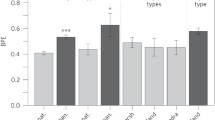Summary
A mathematical analysis of the changes in plant relative growth rates necessary to increase aboveground production following grazing was conducted. The equation derived gives an isoline where production of a grazed and ungrazed plant will be the same. The equation has four variables (mean shoot relative growth rate, change in relative growth rate after grazing, grazing intensity, and recovery time) and may be analyzed graphically in a number of ways.
Under certain conditions, small increases in shoot relative growth rate following grazing will lead to increased aboveground production. Under other conditions, very large increases in relative growth rate after grazing can occur without production being increased over that of ungrazed plants. Plants growing at nearly their maximum potential relative growth rate have little opportunity to respond positively to grazing and potentially can sustain less grazing than plants with growth rates far below maximum. Plants with high relative growth rates at the time of grazing require large increases in growth rate while slow growing plants require only small increases. High grazing intensities are least likely to increase production and high grazing frequencies require greater responses than infrequent grazing events.
Similar content being viewed by others
References
Blackman VH (1919) The compound interest law and plant growth. Ann Bot 33:353–360
Chew RM (1974) Consumers as regulators of ecosystems: An alternative to energetics. Ohio J Sci 74:359–370
Detling JK, Dyer MI, Winn DT (1979) Net photosynthesis, root respiration, and regrowth of Bouteloua gracilis following simulated grazing. Oecologia (Berl) 41:127–134
Detling JK, Dyer MI, Procter-Gregg C, Winn DT (1980) Plant-herbivore interactions: Examination of potential effects of bison saliva on regrowth of blue grama grass. Oecologia (Berl) 45:26–31
Dyer MI (1975) The effects red-winged blackbirds (Agelaius phoeniceus L.) on biomass production of corn grains (Zea mays L.). J Appl Ecol 12:719–726
Dyer MI, Detling JK, Coleman DC, Hilbert DW (in press) Role of herbivores in grasslands. In: Estes J, Tyrl R, Brunken JN (eds.) Grasses and grasslands. Univ Oklahoma Press, Norman, Oklahoma
Evans GC (1972) The quantitative analysis of plant growth. University of California Press, Berkeley and Los Angeles, California. pp 734
Fisher RA (1921) Some remarks on the methods formulated in a recent article on the quantitative analysis of plant growth. Ann Appl Biol 7:367–372
Gifford RM, Marshal C (1973) Photosynthesis and assimilate distribution in Lolium multiflorum Lans. following differential tiller defoliation. Aust J Biol Sci 26:517–526
Golley FB (1973) Impact of small mammals on primary production, In: Gessaman JA (ed) Ecological energetics of homeotherms. Utah State Univ. Monograph Series V. 20, pp 142–147
Grime JP, Hunt R (1975) Relative growth-rate: Its range and adaptive significance in local flora. J Ecol 63:393–422
Hodgkinson KC (1976) The effects of frequency and extent of defoliation, summer irrigation, and fertilizer on the production and survival of the grass Danthonia caespitosa Gaud Aust J Agric Res 27:755–767
Hodgkinson KC, Smith NG, Miles GE (1972) The photosynthetic capacity of stubble leaves and their contribution to growth of the lucerne plant after high level cutting. Aust J Agric Res 23:225–238
Laude HM (1972) External factors affecting tiller development. In: Youngner VB and McKell CM (eds) The biology and utilization of grasses. Academic Press, New York, pp 146–154
Lee JJ, Inman DL (1975) The ecological role of consumers—an aggregated systems view. Ecology 56:1455–1458
Mattson WJ, Addy ND (1975) Phytophagous insects as regulators of forest primary production. Science 190:515–522
McNaughton SJ (1976) Serengeti migratory wildebeest: Facilitation of energy flow by grazing. Science 191:92–94
McNaughton SJ (1979) Grazing as an optimization process: Grassungulate relationships in the Serengeti. Am Naturalist 113:691–703
McNaughton SJ, Coughenour MB, Wallace LL (in press) Interactive processes in grassland ecosystems. In: Estes J, Tyrl R, Brunken JN (eds.) Grasses and grasslands, Univ Oklahoma Press, Norman, Oklahoma
Owen DF, Wiegert RG (1976) Do consumers maximize plant fitness? Oikos 27: 488–492
Painter EL, Detling JK (1981) Effects of simulated grazing on net photosynthesis and regrowth of western wheatgrass. J Range Manage 34:68–71
Pearson LC (1965) Primary production in grazed and ungrazed desert communities of eastern Idaho. Ecology 46:278–285
Reardon PO, Leinweber CL, Merrill LB (1972) The effect of bovine saliva on grasses. J Am Sci 34:897–898
Ryle GJA, Powell CE (1975) Defoliation and regrowth in the graminaceous plant: The role of current assimilate. Ann Bot 39:297–310
Smirnov US, Tokmakova SG (1972) Influence of consumers on natural phytocaenoses variation. In: Wielgolaski FE and Rosswall T (eds) Proc IV Int Meeting Biological Production of Tundra, Leningrad, pp 122–127
Stenseth NChr (1978) Do grazers maximize individual plant fitness? Oikos 31:299–306
Youngner VB (1972) Physiology of defoliation and regrowth. In: Youngner VB and McKell CM (eds) The biology and utilization of grasses. Academic Press, New York, pp 292–303
Author information
Authors and Affiliations
Rights and permissions
About this article
Cite this article
Hilbert, D.W., Swift, D.M., Detling, J.K. et al. Relative growth rates and the grazing optimization hypothesis. Oecologia 51, 14–18 (1981). https://doi.org/10.1007/BF00344645
Received:
Issue Date:
DOI: https://doi.org/10.1007/BF00344645




